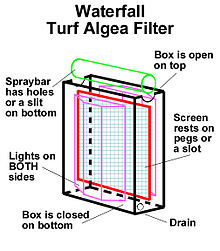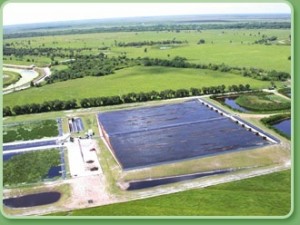Ultimate Filtration (Algae Turf Scrubbers)
Ultimate Filtration (Algae Turf Scrubbers)
Have you been having algae problems in your display tank? Do you feed your fish as much as you would eat? Are you sick and tired of struggling to keep your sand clean? Do you want me to stop asking you questions because the answer is “Yes?” The answer to your problems lies within the mangled screen of what has been called the Algae Turf Scrubber.
An Algae Turf Scrubber, or ATS (not to be confused with ATO) is an amazing innovation in the aquarium hobby. It utilizes Primary Production, the synthesis of organic compounds from atmospheric or aqueous carbon dioxide. (Definition from Wikipedia). This is the same premise that every body of water from the ocean to the smallest of stream use to stay clean and have the stability we try so hard for in our home aquariums.
The concept of the ATS has been around since the 70s but has not been popularized until recently, with the exception of those whose display tanks resembled the ATS unintentionally. Some places have already started using giant outdoor ATS as a means for public water filtration.
This must be an effective device and it takes nature to the next level once more. Not only does it filter out nutrients but it creates a whole new world for life forms you probably would never see otherwise.
So how does it work? There are 3 main designs for the Turf Scrubber. The first concept (and the oldest) was a screen that the water would run over and it had a light.
 The idea was to make this environment much more appealing to hair algae than your Display Tank. When the Algae would grow too large it would get trimmed off and start over. Eventually people started dividing the screen so that it could be cleaned in rotation, thus keeping the hair algae to work.
The idea was to make this environment much more appealing to hair algae than your Display Tank. When the Algae would grow too large it would get trimmed off and start over. Eventually people started dividing the screen so that it could be cleaned in rotation, thus keeping the hair algae to work.
A recent modification is the Up-flow Algae Turf Scrubber, or UATS. I pronounce it “whats?!” I was amazed at its effectiveness and ease to build. This concept is to have the ATS submerged rather than a waterfall. To keep the screen aerated there is an air stone below it flowing upward. They are Easier to make but are they more effective? The answer going to be different for every container of water on the planet.
How do you know what kind of scrubber you want? There are very few ATS on the market, so the odds are you will have to build your own. Here is a good way to help determine what suits your needs.
- Start a build thread-Starting a build thread will peak other people’s interests and help you get opinions from other experienced hobbyists. Here is a great thread with tons of examples and testimonies: Examples and Testimonials
- Determine space constraints- A standard ATS can get gigantic depending on your feeding schedule and tank size, but a UATS could be just as large.
- USE THE FORMULAS!!! Some hobbyists are as close to scientists as they come and have already done the work. If you follow others success yours will soon follow. Once you get a good understanding than you can begin to modify to your exact needs. Here is where to find the formulas for your ATS: Algae Turf Formulas
- Once you have the formulas and a good understanding you can start your design!
Once you own one you will regret spending all that time plucking, scraping, and just growing algae in the wrong place! There is no limit to the amount of food you can feed given the right formula for your habits. Personally I feed up to 11 cubes in my 90 gallon aquarium and used a 29 gallon for a UATS. No Skimmer, No water changes since October of 2012. However Dosing is an extremely important duty when using this method. Due to evaporation, consumption, and misplacement of elements. Reactors and Dosing mechanisms would be a great accompaniment to an ATS.
ATS are capable of replacing your protein skimmers completely. For a device you can make for dirt cheap it is well worth the experimentation at the very least. What is the worse that could happen? A tank crash from too much cleanliness? I highly doubt that.


Leave a Reply
You must be logged in to post a comment.